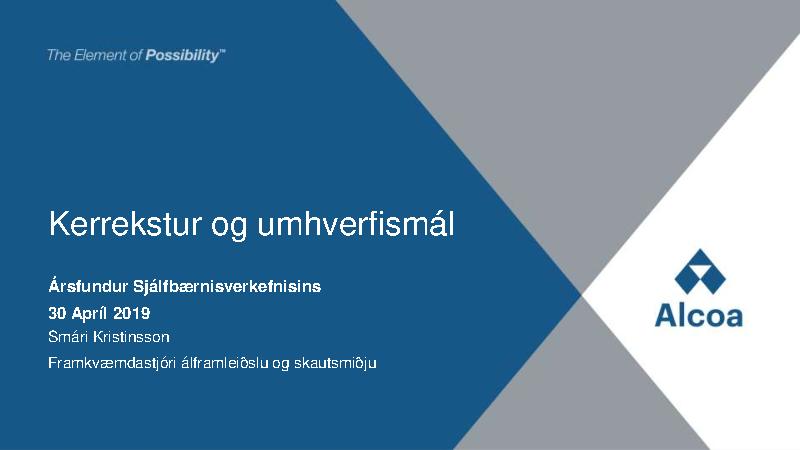Progress
* Disclaimer: The results for fluoride and airborne dust are uncertain for 2012 due to a lack of survey data on the emission through the chimney stack. It is known that from mid-May to August, the emission increased, but data is not available to confirm this increase.
Numbers for 2007 represent the total amount, but not the amount per produced ton of aluminum because the smelter had not yet reached full production:
- Airborne particles were a total of 11.7 kg
- Sulphur dioxide (SO2) was 501 kg
-
Fluoride was 17 kg.
Updated: April 19, 2022
Source: Alcoa Fjarðaál 2009 - 2022
Metrics, Targets and Monitoring Protocol
What is measured?
- Particulate matter, sulphur dioxide (SO2), fluoride (F), and polycyclic aromatic hydrocarbons (PAH) emissions (in kg) per ton of aluminum produced. (Project effect: direct).
Monitorin Protocol
- Continuous emissions monitor for one stack at each scrubber. Monitoring devices will record emissions from:
- Pothouse stack, after scrubbing
- Pot room ventilation air
- Point sources
- Stack dust samples collected randomly
- Information will be collected with an annual "significant measurement" (EOL)
- Airborn fluoride: continuous
- Fluoride in dust, PAH: individual sampling to follow up on annual measurements
- SO2: combination
Target
- Dust (according to EOP):
- Annual average pothouse ventilation, 1 kg/metric ton Al produced.
- Monthly average pothouse ventilation: 1.3 kg/metric ton Al produced
- Exhaust dust from point sources other than pothouse: <50 mg/Nm3
- Total Fluoride:
- Annually pothouse exhaust: 0.25 kg/ metric ton Al produced
- Monthly average for pothouse exhaust 0.8 kg/metric ton Al produced
- SO2 (EOP): To be determined after completion of EIA
Possible countermeasures
Alcoa Fjarðaál and Landsvirkjun have enviromental policies that are set to respect the environment.
See more:
Alcoa Environment
Updated: September 1, 2017
Changes of indicator
This indicator was originally number 17.2a. It was then named Air Emissions and can be found under that number in documents of the project from 2005 and 2006.
The indicator number has been changed twice.
| Year | Nr. | Indicator name |
|---|---|---|
| 2020 | 4.4.6 | Emissions of dust particles |
| 2007 | 2.14a | Air Quality |
Baseline
| Dust particles | Sulfur dioxide (SO2) | Fluorine | |
|---|---|---|---|
| 2007 | Total emissions for the year: 11,7 kg | Total emissions for the year: 501 kg | Total emissions for the year: 17 kg |
| 2008 | 0,42 kg/t aluminum | 11,32 kg SO2/t aluminum | 0,34 kg F/t aluminum |
Rationale for Indicator Selection
Air quality is an important human health issue. Local residents are concerned that the smelter will adversely affect the local air quality and detract from the quality of life in Reydarfjordur. The sustainability of the local communities is, in part, dependent on desirable living conditions and the quality of the local environment. Emissions from the smelter will have a direct effect on the air quality in East Iceland.
From phase I/II report on indicators and baseline from April 2005
Further reading

Atmospheric emissions are discussed in more detail in Alcoa Fjarðaál's Community Report.
